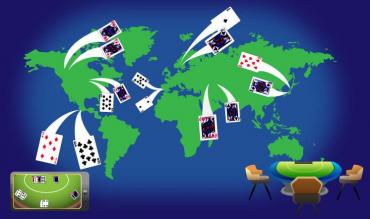The premise of playing blackjack is simple: beat the dealer's hand total without exceeding 21. This is true everywhere in the world, including the USA, Canada, Europe, Asia, and across Africa. However, there are differences in how blackjack is played vis-à-vis the rules.
Below, you will see the differences in blackjack rules between the US and overseas countries.
| United States Blackjack Rules |
Overseas Blackjack Rules |
|---|---|
| Mainly played with six decks of cards, but single and double-deck games are available. |
Most blackjack games are played with six decks of cards, and the rules aren't as player-friendly. |
| The dealer takes a pocket card before players can play their hands. | Regarding the No-Hole-Card rule, blackjack dealers don't take their second card until after players have completed their hands. |
| Only the initial wager is lost when a player doubles on a pair split and loses to a dealer blackjack. |
The acronym for the European No Hole Card Rule is ENHC. All wagers are lost if you pair split or double down and lose to a dealer's blackjack. |
|
Late surrender is common. Players can surrender their hands only after the dealer has checked for (and doesn't have) blackjack. |
Some foreign casinos allow early surrender. That means you can surrender your blackjack before the dealer checks for blackjack. |
| For the most part, insurance is only available to players when the dealer's upcard is an Ace. Several casinos permit players to take insurance when the dealer has a 10-value upcard. | In several online casinos across Europe, and at land-based casinos, particularly in the UK, it's only possible to place an insurance bet when you have blackjack. These bets pay even money. |
| US casinos frown upon card counting. |
Overseas, many games are better for card counters to play. Bigger bet spreads are also available. |
| Players must declare any foreign winnings greater than $10,000 in cash or monetary instruments upon re-entry to the US. | Players from the US have to contend with issues like forex exchange when going overseas and returning to the US. Players are often required to carry large amounts of cash when abroad. |
| Players can use an alias and be legally rated in the US. |
US blackjack players routinely show their passports for ID purposes in overseas casinos. It is a criminal offence to use a fake ID. |
| The majority of blackjack games pay at 6:5, with continuous shuffling machines. Games include Spanish 21, Super Fun 21, Vegas Blackjack, and Atlantic City Blackjack. Side bets are also available such as Lucky Ladies and Royal Match. |
Blackjack players are more likely to find games that pay 3:2 for untied blackjack. There are no side bets and very few blackjack variants, except for Pontoon. |
What Is the No Hole Card Rule?
This rule states that dealers don't take their second blackjack card until after playing their own hands. Many players mistakenly believe that this rule means that the casino has the edge over the player. Why? It's the case because the dealer is less likely to bust when cards are dealt consecutively, as opposed to when the dealer's second and other drawn cards are dealt. Since this occurs after players have received their cards, it creates a little confusion with blackjack players.
It makes no mathematical difference over the long term. Whether the dealer takes a second card before or after player acts is irrelevant. The odds of blackjack remain the same regardless. This No Hole Card rule doesn't change the basic playing strategy for players either. If you're holding a hand value of 16 and hold it, it's possible to play your hand the same way, regardless of whether the dealer holds a hole card.
The European No Hole Card Rule
The European No Hole Card Rule is a variation of typical blackjack games. In some European countries, players will lose the total value of their splitting and doubling if the dealer has a blackjack. This rule is typically in place at land-based casinos. When the dealer's second card results in blackjack, the odds will be affected if the player loses. The house edge can increase by about 0.11%, not substantial but significant for serious blackjack players. This rule also requires an adjustment of basic blackjack playing strategy.
Below, you will see a table indicating all the differences that come into play with a multi-deck European No Hole Card Rule Game where the dealer hits on a soft 17, and players can double after splitting pairs. This table compares the ENHC to the American games using the same rules of play. The strategy changes when the dealer has an Ace or a 10.
The following rules apply:
* When the dealer has a 10, hit on a hard 11
* When the dealer has an Ace, hit a pair of Aces
* When the dealer has an Ace and 10, hit a pair of eights
| American Rules | ENHC | |||
| Player Hand/Dealer Upcard | 10 | Ace | 10 | Ace |
| Hard 11 | Double | Hit | Hit | Hit |
| Ace-Ace | Split | Split | Split | Hit |
| 8-8 | Split | Split | Hit | Hit |
The table above indicates the changes required for basic blackjack strategy when European No Hole Card rules are in effect. The assumption is that there is no surrender option. In other posts, we will be discussing the basic blackjack strategy modifications when surrender is available to players.
